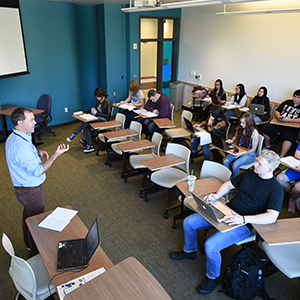High Impact Practices

Salt Lake Community College (SLCC) is committed to fostering High Impact Practices (HIPs) throughout its curriculum. Identified by George Kuh and popularized through the efforts of the Association of American Colleges and Universities (AAC&U), HIPs are specific pedagogies that—when done well—have positive effects on deep learning, student retention and ultimately student success. They ask students to produce educationally purposeful work that is the result of sustained engagement with unscripted challenges, using active and self-reflective methods in realistic contexts, and marked by formative and summative feedback from faculty and peers.
Kuh originally identified ten HIPs, to which the AAC&U added ePortfolio pedagogy in 2017. At SLCC, we have identified and defined the following 14 HIPs that we encourage faculty to use in their courses:
How to Apply for Funding
The President’s Office financially supports students participating in High-Impact Practices (HIPs). The primary purpose of this initiative is to broaden the pool of students who can participate in HIPs with cost barriers. Therefore, nominators should ensure that they are targeting the funding to support first-generation students, students with financial needs, and/or students who are members of underrepresented populations.
Funding can be reimbursed for experiences for students that include conference or workshop registration, flights, hotel costs, or other expenses related to participation in a HIP. Students need to present to receive funding to attend a conference. The funding cannot pay for employee expenses. If you are nominating a group of students, please list one student on the form when applying and then indicate that the proposal is for a group experience. You will then receive a link to a form where you can submit info for the group. Group leaders and individuals requesting funding will all need to fill out the HIPs Application for Support form by clicking on the button below.
Please note expenses will be reimbursed to the nominators department using the ChromeRiver reconciliation report. A final report must be completed at the end of the activity. All students must also document their experience in their ePortfolio.
Priority review deadlines are:
- Fourth Monday in October
- Fourth Monday in November
- Fourth Monday in January
No funding will be provided for experiences after commencement for the open call.
Proposal guidelines
- Please provide an explanation of the activity and how it aligns with high-impact practices (HIP).
- High-impact practices engage and retain students. Please describe how your activity will do this.
- The funds should primarily be used to support first generation students and students of color. Please articulate your plan to include students who are traditionally underrepresented in HIPs (first-generation college students of color, students with disabilities, veterans). Students should also have a financial need, but the first two categories should be prioritized.
- What are the expected learning outcomes for the activity? These can be academic, skill-based, interpersonal or equity focused.
- How will a diversity of perspectives and interactions be incorporated into the activity?
- A requirement for funding includes students posting about their experience in their ePortfolio. Students need to start their ePortfolio in advance (before the experience) and then complete it when they return. What is the plan to ensure that students post about the experience in their ePortfolio? Please include ePortfolio links in advance if feasible.
ePortfolio Documentation requirements
Organizers of HIPs should communicate to students that they are expected to showcase and reflect on the experience in their ePortfolio. Students should have their ePortfolio and the page for the HIP set up before they engage in the experience that they will be documenting and reflecting upon. Here is a rubric that should be communicated to students early on:
Showcasing. The experience is engagingly documented in the student’s ePortfolio with effective textual description and interesting multimedia representations—e.g., photos, video, graphics, and audio files.
Reflecting. The student engagingly reflects on the experience in a way that makes connections, elaborates on impact, questions assumptions, demonstrates personal growth, refines their goals, or helps the reader better understand the significance of the experience.
Rubric for Showcasing and Reflecting on HIPs in the ePortfolio
| 3 | 2 | 1 | 0 |
|---|---|---|---|
| Showcasing. The High Impact Practice is engagingly documented in the student’s ePortfolio with effective textual description and interesting multimedia representations. | The High Impact Practice is not depicted in the student’s ePortfolio. | ||
| Reflecting. The student engagingly reflects on the High Impact Practice in a way that makes connections, elaborates on impact, questions assumptions, demonstrates personal growth, refines their goals, or otherwise helps the reader better understand the significance of the experience. | There is no reflection about the student’s High Impact Practice experience. |